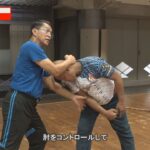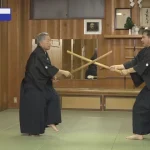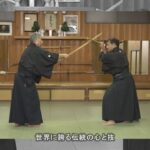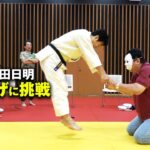Text and Photo by Grigoris A.Miliaresis
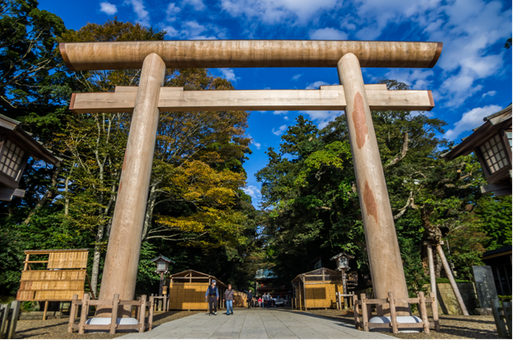
“I wonder who that is” said the elderly lady standing next to me in front of a relief, deep in the forest surrounding the Kashima Shrine; she was part of a small group who had come to the shrine for a tourist visit that rainy autumn morning. “Let’s take a look behind it” ventured a more determined elderly gentleman who was also part of the group “I’m sure there will be some explanation”. The rest of the group were standing idly around the relief carved in what looked like grey granite and were taking pictures of the long-haired man with the solemn look in his eyes who was standing on the back of a giant catfish and were mumbling theories about the image. Although I managed to resist the temptation to show off, I was taken aback: how could it be that people of that generation (ca. 60-70 years old) didn’t know of the earthquake-causing Namazu and the deity that kept it under control, Takemikazuchi no Mikoto also known as Takemikazuchi no Okami or simply Kashima no Kami or Kashima Daimyojin, the reason for existence of the very shrine they came to visit?
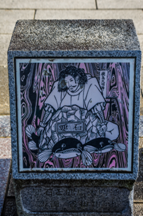
Times have changed -obviously. In our day and age everyone knows that for the tremors that shake these islands we can’t blame a giant catfish living in the depths of the Earth and that even if Kashima no Kami hasn’t gone to Izumo Taisha for the Kamiari-zuki/Kanna-zuki gathering of the gods, he can hardly protect the land no matter how firmly he holds the kaname-ishi stone. The namazu-e woodblock prints of the late Edo times have disappeared in museum vaults and libraries and it seems as if the only people who keep alive the marvelous story of the deity that was born from a sword by the deities that created Japan are, besides priests, a few martial artists -the people who think of the great Ibaraki shrine as their spiritual home and the womb from which some of Japan’s most exciting martial traditions have sprung.

It wasn’t by chance that I went to Kashima Jingu that day: like all the other times I’ve been there it was to watch an enbu dedicated to the Kashima deity –although I enjoy visiting shrines and temples as much as the next guy (and perhaps more because of a special fascination with religion and particularly Japan’s rich religious tapestry), I could never think of this shrine as just another place to visit, shoot a few pictures, buy an omamori or a red seal and move on to the next. Kashima Jingu is the closest the martial arts have to a holy ground so being there without some martial arts’ event going on seems to me almost unnatural. Anything and everything related to the shrine –from the shops in its omotesando road to the very deity it hosts and from the relics displayed in its treasure house to almost all milestones in its history- are connected to and informed by the arts of war.
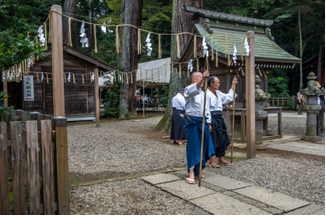
The cracking of the weapons of the Kashima Shinto-ryu on the small stage set right across the shrine’s haiden or front shrine was the perfect soundtrack to start thinking about what it was that made the particular shrine so important for martial artists. My personal theory and one that many subscribe to was that it was the fortuitous coincidence of having in the area two very important swordsmen, Matsumoto Bizen-no-Kami Ki no Masamoto, the progenitor of Kashima Shin-ryu and Kashima Shinden Jikishinkage-ryu and Tsukahara Bokuden, founder of Kashima Shinto-ryu but even a superficial reading is enough to understand that the thing goes way back. Because of the origins of Takemikazuchi (he was born out of the blood that sprang from Japan creator’s Izanagi-no-mikoto’s sword, Totsuka-no-Tsurugi when the latter killed his son Kagutsuchi, the god of fire), the deity was connected to the arts of war from the beginning -his future as a subjugator of the native deities or “kunitsukami” and as the alleged creator of sumo (after his fight with Takeminakata) made the connection even stronger.
What took me some time (and a relocation to Japan) to realize was the precise passage from the mythic worlds of the “Kojiki” and the “Nihon Shoki” to the world of the very real swordsmen bushi of the Muromachi period. Apparently this came through some ceremonial sword dance that the priests of Kashima Jingu used for purification purposes -this is the illustrious “Kashima-no-tachi” that can be found in the background of all traditions tracing their lineage to the Ibaraki shrine. The conduit for this transformation was by most accounts a 7th century attendant of Kashima Jingu, Kuninazu no Mahito who reportedly received divine guidance from Kashima no Kami himself; from there on the symbolic art, still alive in the shrine’s ceremonies (albeit performed with an onusa stick with shide paper zigzag streamers) developed into an actual martial art which the founders of the Kashima styles would fine-tune even more in the early 16th century.
Fascinating as all these are (and from the viewpoint of a student of martial arts, tracing the arts’ technical development alone i.e. bypassing the other cultural elements, is itself an exciting and rewarding pursuit), the journalist in me can’t ignore the political aspects: because of its geographical position and because of its huge estate, visible even today in the forest surrounding it, Kashima Jingu (as well as Katori Jingu in Chiba, another shrine with a long relationship with the martial arts -and with Kashima Jingu) was an important strategic point for the wars between the Yamato nation and the Ezo/Emishi nations. I can’t believe that it is a coincidence that the founding of the Kashima shrine and its rise in importance happened roughly at the same time that the Emperor’s troops campaigned against the eastern tribes: at times as turbulent as those, having a stronghold so close to the enemy is a priceless asset so it was only natural that the Imperial Court would overemphasize both its religious prominence (by giving it a status similar to that of the Ise Jingu) and its relationship to the arts of war.
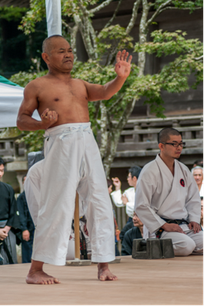
On the stage, the group from Kashima Shinto-ryu had given its place to Okinawa Goju-ryu Bujutsu, a group demonstrating traditional strengthening exercises for karate practitioners before moving to their style’s kata; even though the older karate schools are as far removed from the Japanese traditions as are the Ryukyu Islands themselves from Ibaraki, they didn’t seem out of place. Karate has been a part of the fighting arts landscape of Japan for over a century and its vines have become so much interwoven with those of the four main islands that for many years (perhaps even today?) the very word was a synonym for the country’s martial arts in general. Which, by the way and irony aside, might not be that improper after all: the pechin of the Ryukyu who were responsible for its creation and development were the local equivalent of the samurai so the similarities are there -and this becomes even more apparent in their armed kata which involve the use of swords, spears and naginata.
And we are back to the sword, that most emblematic of all the weapons in the traditional Japanese arsenal. I still find it amazing that a weapon most contemporary historians agree was never the primary choice for the battlefield came to be called “the soul of the samurai”; there is little doubt that this characterization came during the Edo times, when the bushi took off their armor and became Japan’s ruling class but going back to the Kashima-born traditions, the major figures are mostly known as swordsmen and heirs to the divine sword legacy of Takemikazuchi. I doubt there are any people of the martial arts who when coming across the names “Tsukahara Bokuden”, “Matsumoto Bizen-no-Kami Ki no Masamoto” or “Kamiizumi Ise no kami Fujiwara no Hidetsuna”, the almost legendary figures of the Kashima schools don’t think of a man with a sword.
Still, those men were warriors, not duelists; their fame was built for the most part on their successes on the battlefield –Tsukahara Bokuden had also a sterling reputation as a victorious participant in several duels but considering the times he (actually all of them) lived in, this was of secondary importance- so it’s safe to assume that they were even more proficient in the use of other weapons more appropriate for battle. So was their celebrated prowess with the sword a byproduct of a well-rounded martial education (the sword might not have been the primary battlefield weapon but it was used in battle even as a secondary choice) or was it that precisely because they were related to the Kashima Jingu, those legendary fighters needed to also attain a certain level of proficiency in swordsmanship so they could better embody the principles of the divine art of the shrine’s sword-born and sword-yielding deity?
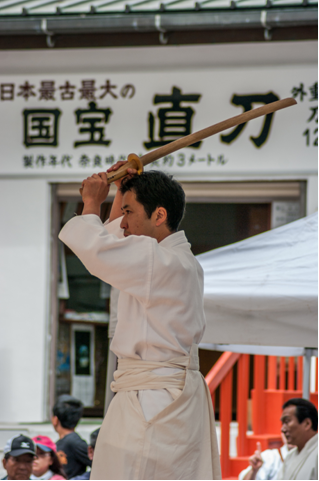
In the enbu, the Goju-ryu group gave its place to the Bokuden-ryu (another school owing its existence to the eminent son of the area) and then to Sekiguchi-ryu, Daito-ryu Aikijujutsu, Taisha-ryu and more, up to the Hozoin-ryu, the Yagyu Shinkage-ryu and from there to the Tenshinsho-den Katori Shinto-ryu –an appropriate mix of different traditions considering that looking at the histories of Kashima’s famous fighters one sees all kinds of entanglements regarding who was taught by whom, when it happened and what it entailed; what makes things even more interesting (and more chaotic!) is that theirs aren’t the only names involved in the history of the Kashima area. Names like those of Iizasa Yamashiro no Kami Choisai (of Katori Shinto-ryu fame), Arima Yamato no Kami Kiminobu (the founder of Arima-ryu), Hozoin Kakuzenbo Inei (Hozoin-ryu) and even that of daimiyo and general Takeda Shingen pop-up in various points allowing for all kinds of theories regarding the crosspollination of principles, strategies and techniques.


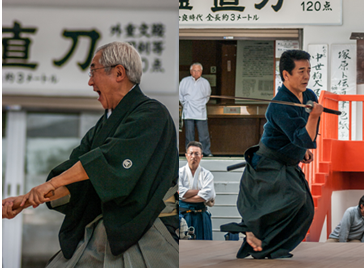
The demonstration was over early in the afternoon -like all demonstrations it was a mixed bag of moments varying from the extremely interesting to the indifferent (this has less to do with the schools themselves and more with the form of the demonstrators in any given day) and the participants started to pick up their things and socialize: enbu are always an opportunity for rekindling of acquaintances, catching up and, not infrequently, plain gossip (the world of koryu is small). Since we still had some time to spare, we wandered around in the forest surrounding the shrine, mixing ourselves with the tourists and marveling at the nature that was refreshed from the rain and at the Jingu’s treasures, manmade (like the enormous chokuto sword in its treasure-house) or natural (like the sazame ishi next to the deer pen). And of course we couldn’t not stop at the kaname ishi, the stone Kashima no Kami used to pin down the ferocious namazu.
In Greece, at the Oracle of Delphi there was a spot which was supposed to be the “navel of the earth”: the Oracle was of great importance to the world of the Ancient Greeks so it was only natural that they would try to assign to it a cosmological significance -it was, after all, the place where people could communicate with the deities and its location was chosen by Zeus, the god of lightning. Every time I visit Kashima Jingu’s kaname ishi, I can’t help thinking its parallels to the Delphic “omphalos”: it too is a central point of the Earth since the Japanese god of lightning/thunder is using it to help keep the land in its place. Considering the distance between Japan and Greece and the minimal contact between the two civilizations, it’s amazing how the people of both lands, had similar ideas and expressed them in similar myths.
By extension, and because I’ve been involved with the martial arts long enough for these kind of thoughts to come naturally, the Kashima Jingu is itself a kaname ishi, an omphalos -of the martial arts. For the reasons mentioned above and, perhaps for others that have been lost in the tides of time, the shrine of the Hitachi Province became a womb from which sprang many of Japan’s most noteworthy fighting traditions. The Kashima schools are among the oldest in the land and because of their seniority, the skill of their most prominent exponents (and the fame that came with it) and of course their technical merits, they have influenced and informed many of the schools that followed and even some of the modern martial arts -aikido is the most noticeable example of this evolution.
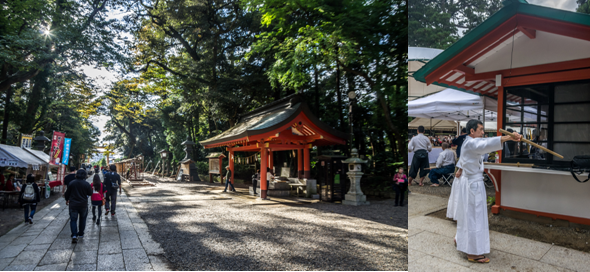
Passing under the enormous torii gate, freshly made of trees from the Kashima forest to replace the one made of concrete which was destroyed that day in March 2011, we went down the omotesando road and stopped for a few omiyage gifts for friends and family. The shops, like many souvenir shops all over Japan, offered among other things bokuto wooden swords but these ones were different: they weren’t of the generic shape used for the kata of kendo but had the shape of the bokuto used in Kashima Shinto-ryu and they had the name of the school fire branded on their hilt. And even though I doubt they are suitable for actual practice, there were several tourists buying them -the atmosphere of the Kashima Jingu, the shrine of the martial arts is impossible to resist.
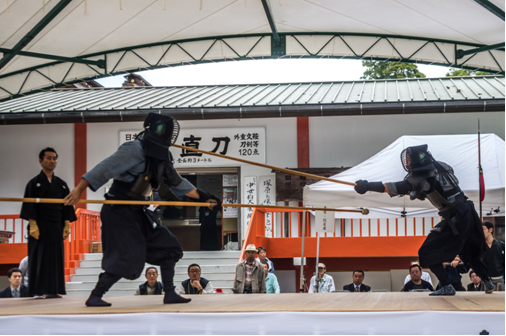


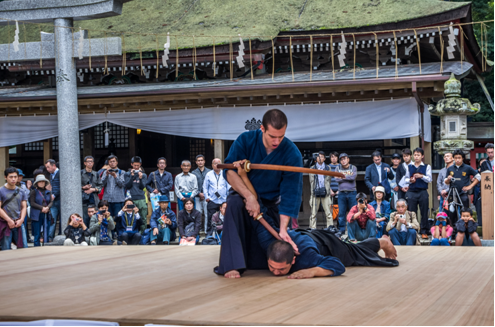
 About the author
About the author
Grigoris Miliaresis has been practicing Japanese martial arts since 1986. He has dan grades in judo, aikido and iaido and has translated in Greek over 30 martial arts’ books including Jigoro Kano’s “Kodokan Judo”, Yagyu Munenori’s “The Life-Giving Sword”, Miyamoto Musashi’s “Book of Five Rings”, Takuan Shoho’s “The Unfettered Mind” and Donn Draeger’s “Martial Arts and Ways of Japan” trilogy. Since 2007 his practice has been exclusively in classic schools: Tenshin Buko-ryu Heiho under Ellis Amdur in Greece and Kent Sorensen in Japan and, since 2016, Ono-ha Itto-ryu under 17th headmaster Sasamori Takemi and 18th headmaster Yabuki Yuji.
http://about.me/grigorismiliaresis






